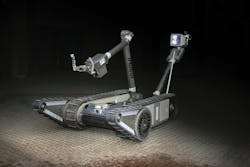Artificial intelligence (AI) to enable manned and unmanned vehicles adapt to unforeseen events like damage
ARLINGTON, Va. – U.S. military researchers are asking industry to develop artificial intelligence (AI) systems that respond well to conditions and events that these systems have never seen before.
Officials of the U.S. Defense Advanced Research Projects Agency (DARPA) in Arlington, Va., released a presolicitation on Friday (HR001121S0036) for the Learning Introspective Control (LINC) project.
LINC aims to develop AI- and machine learning-based technologies that enable computers to examine their own decision-making processes in enabling military systems like manned and unmanned ground vehicles, ships, drone swarms, and robots to respond to events not predicted at the time these systems were designed.
LINC technologies will update control laws in real time while providing guidance and situational awareness to the operator, whether that operator is human or an autonomous controller.
Related: Artificial intelligence and machine learning for unmanned vehicles
Today's control systems seek to model operating environments expected at design time. Yet these systems can fail when they encounter unexpected conditions and events.
Instead, LINC will develop machine introspection and learning technologies that can characterize unforeseen circumstances like a damaged or modified military platform from its behavior, and then update the control law to maintain stability and control.
A LINC-equipped platform will compare the behavior of the platform, as measured by on-board sensors, continually with a learned model of the system, determine how the system's behavior could cause danger or instability, and implement an updated control law when required.
This could be an improvement of today's approaches to handling platform damage, which places the burden of recovery and control on the operator, whether that operator is human or an autonomous controller.
LINC will help operators maintain control of military platforms that suffer damage in battle or have been modified in the field in response to new requirements. LINC-enabled control systems will build models of their platforms by observing behavior, learning behavioral changes, and modifying how the system should respond to maintain uninterrupted operation.
LINC should be able to detect disruptive changes in control response and quickly develop a control regime based not only on the learned model, but also on changes that take place after the model has been learned.
LINC focuses on two technical areas: learning control by using onboard sensors and actuators; and communicating situational awareness and guidance to the operator.
Learning control by using onboard sensors and actuators will perform cross-sensor data inference to characterize changes in system operation, rapidly prune possible solutions to reconstitute control under changed dynamics, and identify an area of nondestructive controllability by continually recalculating operating limits.
Communicating situational awareness and guidance to the operator involves informing the operator of changes in system behavior in a concise, usable form by developing technologies to provide guidance and operating cues that convey details about the new control environment and its safety limitations.
LINC will be a four-year, three-phase program; the first phase will last for 18 months, and the second and third phases will last for 156 months each.
Initial work will involve an iRobot PackBot and a remote 24-core processor. This ground robot weighs 20 pounds; measures 26.8 by 15.9 by 7.1 inches; has tracked and untracked flippers; moves at 4.5 miles per hour, and operates in temperatures from -20 to 50 degrees Celsius.
The remote processor has an Nvidia Jetson TX2 general-purpose graphics processing unit (GPGPU), dual-core NVIDIA Denver central processor, Quad-Core ARM Cortex-A57 MPCore processor; 256 CUDA software cores, eight gigabytes of 128-bit LPDDR4 memory, and 32 gigabytes of eMMC 5.1 data storage.
Related: Artificial intelligence and embedded computing for unmanned vehicles
A key goal of the program is to establish an open-standards-based, multi-source, plug-and-play architecture that allows for interoperability and integration -- including the ability to easily add, remove, substitute, and modify software and hardware components quickly.
Companies interested should upload proposals to the DARPA BAA website no later than 26 Oct. 2021 at https://baa.darpa.mil. Several awards are expected.
Email questions or concerns to DARPA at [email protected]. More information is online at https://sam.gov/opp/5103486731854edeb65992a7495f3408/view.
About the Author
John Keller
Editor-in-Chief
John Keller is the Editor-in-Chief, Military & Aerospace Electronics Magazine--provides extensive coverage and analysis of enabling electronics and optoelectronic technologies in military, space and commercial aviation applications. John has been a member of the Military & Aerospace Electronics staff since 1989 and chief editor since 1995.
